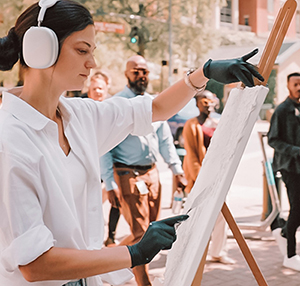Participants: Olga Banartsev, Alex Ag, Armine Bozhko, Vladimir Deming, Elena Dobrovolskaya, Miroslav Duzinkevich, Vasyl Kadar, Marina Kalinovsky, Kira Koktysh, Yelena Lezhen, Lidia Mikhaylova, Anna Miklashevich, Olga Nenazhivina, Viktoriya Rakhmanova, Petro Smetana, Ruslan Tremba, Tetiana Ridosh.
.
Curator – Tatyana Borodina
About ARTISTS
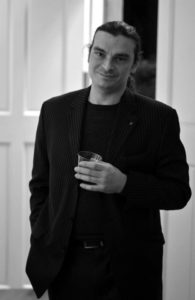 Alex AG
Alex AG
is a New York based photo artist. Both his artworks and the TV show about photography are focued on the experimental aspect of the media. AG believes that we experiencing a ‘decisive moment’ in history of photography, an epoch that will be known for changing the face of this form of art forever. Alex values and uses the wealth of knowledge accumulated by the media in over a century of its history, and at the same time embraces the changes we are witnessing. Hr strides to stay on the frontline of these changes both artistically and in a capacity of art theoretician.
This year Alex AG have released completely new set of collections. 2019 was characterized by several series, that aim to explore a specific concept beyond context of just one work. Notable collections added this year include Children of The Summer – the series of works exploring the process of growing-up and adaptation to rapidly changing world; Elements – the series of works based on four elements in alchemy; Yoga – the series combining landscapes with body movements of Yoga practice, and several others.
Recent collections of Alex AG are based on bright primary colors, and bold underlining idea, surrounded with conspicuous details, forming a complex narrative of the image.
Compared to older collections – mainly devoted to visuals of architecture, sometimes accompanied with image of a person – present works are actively focusing on telling the story of a human being, sometimes quite a simple story, but often a complex idea, which can have number of interpretations.
The imagery of people included in these works party come from studio work, performed specially for the purpose of creating these narratives, and partly are results of street photography shoots, which were the very first genre of photography Alex AG was working in.
 Armine Bozhko:
Armine Bozhko:
«I base my paintings not on a certain place and moment, but rather on the nostalgic feeling of passing time and a dream. The dream for me is an abstract dimension, devoid of time, distance, and place.
We all look at the world through the prisms of our emotional experiences and often associate a certain place with a feeling we experience. Our vision of the surrounding world is always colored by the feeling we have, and it is our very unique experience. In a similar way, my works are the landscapes of my emotional states rather than a description of a place.
Color, a strong interest for me, has always been a focus of my artistic explorations and studies. Color speaks directly to our feelings. It appeals to our emotional perception of the work and allows an artist to lead the viewer into the experience of the feeling invested into a work of art. The themes of my work appear around the feeling, and then I respond through the color. I define painting as feeling traced on the surface of a canvas.
 Vladimir Deming:
Vladimir Deming:
When I designed this collection, my aim was to create unique, sophisticated and dramatic jewelry. It is essential that this jewelry would not only complement an outfit, but also accentuate its style.
In my work I reveal the beauty, hidden in the mediums I use. Simplicity of designs, dramatic combination of materials, balanced proportions, classical and contrasting combination of colors result in a specific recognizable style of my work.
This type pf jewelry usually called Art Jewelry, but I prefer to call my jewelry – Decorative Jewelry because they decorate the outfits.
My deep persuasion, that to use inexpensive, man-made and natural materials gives to designer much more freedom to create very beautiful jewelry, then using precious metals and stones, because they put designer in a very tight cost frame.
The value of designer’s creation in the design itself, not in the material he is using. The most famous paintings of masters were painted on a simple canvas and simple paint, which cost less then material I use. It means that the cost of designer’s jewelry does not depend on material, but on fantasy and execution of the creation.
I designed and made this collection for those, who want to look elegant, different, add artistic accent to their look and attract attention.
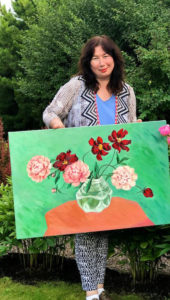 Elena Dobrovolskaya
Elena Dobrovolskaya
«First of all I need to say I am a realist. That means I am drawing and painting a real objects and people around me. I know I am “out of trend” because an abstract and imaginative art has taken a leading role now, which is quite disappointing. There are so many beautiful things in our life (reality), you just need to notice it. So here we go to the artist’s task – to notice and show it to the others, adding a little bit of your personal touch. There is a whole artist’s life inside this “ little touch” – his thoughts, his experience, his taste and his vision. As a result the real life picture looks differently in different artist’s works.
Looking at my portraits, people are usually saying something about Gauguin or Van Gogh resemblance, perhaps because of my color palette. I do want to say that I found my inspiration in the portraits of late 15th century German artists like Hans Memling (my favorite), Albrecht Durer, Hans Holbein the Elder and others. They belong to the Northern Renaissance period and have this beautiful elegant simplicity (which is false by the way), a fine silhouette definition on the sole-colored background, triumph and dominance of Her Majesty Line, herefrom they look more like graphic works than oil paintings. I love that, as the drawing itself is very important for me. I started as a graphic artist and brought it into my oil works. Also their ability of using just a few colors is fascinating and so powerful! It immediately catches the viewer’s eye from any corner of the room but when they approach the portrait attracted by Color, they are seeing only the Face, everything else is flickering out… that is Mastery!
I do not hope to even approach this level of excellence, but they have inspired me tremendously. In my portraits I am trying to use only two main colors except body tone itself which is lightening up in front of this setting. I also love to stage classical poses for my models but together with the bright color palette it looks rather modern as a result.
 Miroslav Duzinkevich
Miroslav Duzinkevich
Pastoral, arlekinada, still life – these are the main topics of the work of Miroslav Duzinkevich. The works are executed exquisitely by the master with some kind of special personal rational manner. It seems that each work has condensed the ongoing artistic culture and tradition. That is faciliated by an extraordinary restraint, a strict selection, and the vintage manner of painting, which is based on the traditions of either the Renaissance, classicism or Venetian secession. Each one of his works is a ‘constellation’, open for contemplation and it lives in the space of the work, through a subtle design, while the balanced combination of the elements continuously transforms and enriches the image to a poetic allegory. Miroslav tries to avoid any comparison to the styles of the past ending up in mysterious incomprehensible corners of the imagination which don’t result in a conflict with the world. His style conveys an anticipation, an uneasy emotional static, the enveloping of all external circumstances of being by the artistic sensitivity. An artist always works towards the goal of harmony and visual allegories that completely free the imagination.
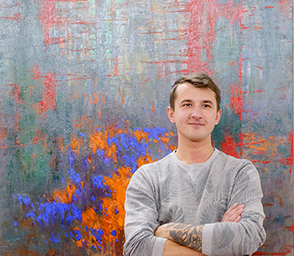 Vasyl Kadar
Vasyl Kadar
is the representative of the young generation of Transcarpathian school of painting which is defined by the synthesis of folk traditions’ transformations, particular color culture, and associativity of figurative thinking. The artist remains faithful to canonic concept of art as an exceptional means of expression where color and light are the fundamentals which assist to recreate the individual experience from the space and the surrounding world perception.
 Marina Kalinovsky:
Marina Kalinovsky:
«The museum was our second home. This half-ruined enchanted place with Greek amphorae and medieval armor at hand probably still inspires images in many of my paintings and drawings.
The images come from the past, from longing and memories, but they are always provoked by combination of colors or the beauty of a gesture. There is hidden magic in everyday life. As each image has reflections, one can peel them endlessly, layer by layer.
During my college years my biggest influence and inspiration was Ludmila Kutsenko, a wonderful artist, and a very demanding teacher. Her credo was honesty and devotion to Art, no matter the circumstances.
Talented and extremely devoted to art people whom I was lucky to meet in my life, (including my husband) were, probably, the best inspiration for me.
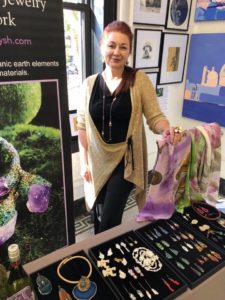 Kira Koktysh
Kira Koktysh
The works presented on the exhibition are the continuation of the artist’s jewelry collections “Mushroom – Another Kind of Fruit”, “The Mistress of the Copper Mountain” and “Poetry without words”.
The works are done in Chinese brush painting technique. Materials used – Chinese ink on rice paper, Chinese ink on silk. Single brush strokes in monochromatic tones are very emotional and strikingly sincere. Brevity and spontaneity of work reflects the essence of the subject and invites the observer to deduce all that remains untold by the author.
Y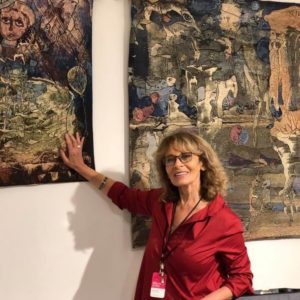 elena Lezhen:
elena Lezhen:
I remember when Steve Jobs spoke at Stanford about connecting the dots as one goes through life. Yes, our life can be imagined as a puzzle that connects feelings, relationships and actions. We work through this puzzle of life, deciding and making our next moves. However, the process of putting our life together is very different than navigating a jigsaw puzzle. There is no predetermine path that guarantees “successful” completion. Building our life puzzle is a chaotic process where we select our next move in the infinite space of possibilities.
The artistic process I go through when I create my art is like building puzzle. My artistic puzzle takes place in a random space of memories, imagination, and emotions that I experience at a given time. I am rather trying to build a puzzle than to resolve it as it takes place in a life. But I do take steps towards its resolution by reflecting in my artworks my feelings and beliefs using tools – symbols, colors, and techniques – that I have at my disposal. As I create the puzzle of life on canvas, I’m ultimately – consciously or not – driven by the reality we live in, which puzzles us all to no end.
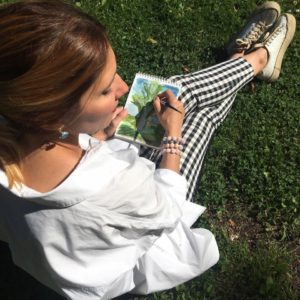 Lidia Mikhaylova:
Lidia Mikhaylova:
«The fall of 2019 has been one of the happiest and most fulfilling falls in my life. My art had an opportunity to travel across the ocean, and to be seen by the eyes of distinguished American viewers. “My Sweet Fall” series is about enjoying the change, as well as anticipating the transformation. Playful, full of flavors, with an overtone of nostalgia, it’s like falling in love with someone new, and knowing your life is about to change.
 Anna Miklashevich:
Anna Miklashevich:
«When I start to paint I do not start with a shape or an idea. In the first place I see the color of the future painting. I usually imagine two colors which will combine on the verge of contrast and create a sense of the painting. I don’t have ambitions to paint portraits of real people and describe their appearance. I seek personal inner characteristics in order to select one and describe it with dint of colors, wide strokes and contrast, to display the things that have been seen and found. I adore contrasts because they are like bricks of which people’s lives are built.
Partly this is the reason why I paint portraits of women most of all. I understand women’s characteristics better (at least I hope so) and women are more complicated and mysterious for this kind of research. My inner state even changes several times while I paint.
Dignity, freedom, pride, power of sight, brightness, intuition, inner senses, etc. All these topics touch me and provoke to depict and manifest them on my canvases.
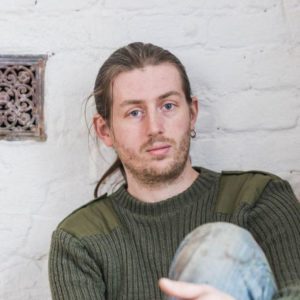 Petro Smetana
Petro Smetana
With only a suggestion of place, the man-made and the object, Petro Smetana’s paintings are masterfully expansive and tend toward the impossible sum of the present moment, the past, and the future — what was manufactured, built and its far-reaching fall-out. He doesn’t allow his work to be classified as either abstract or figurative. One moment he seems an abstract painter uniquely attuned to the physical world and another he seems an observational painter with a command of the abstract elements of painting. What he seeks is that which lies between the two.
As a technically demanding artist, Smetana is just finding his way. What’s distinctive about his paintings is their progressive appearance, with slabs of paint of natural and unnatural coloration that he often literally lays on with putty knives, spatulas and trowels. The lumps of colors are pleasing in themselves, showing subtle modulation, variety and an intrinsic feel for balance. Move one of them a little, and the effect is spoiled.
Of Smetana, art historian Dmytro Korsun remarks, “He paints only what has remained in his memory and what is greater than just a fragment of time and space. In case with Smetana’s paintings we have caught the world on the verge of destruction — buildings are undermined, yards are in ruins, pipes of plants are passive; everything is ready to fall down just as scenery at the end of a theater play. But, the artist doesn’t turn a blind eye to something that is unworthy of art — concrete fences, soot of abandoned industrial areas, smut, various bits and pieces used in the course of life. When the painter thinks all this over, these objects become a brilliant material of art. Smetana’s paintings produce complicated feelings: they attract yet at the same time disturb, evoke admiration without subscribing to the popular notions of beauty.”
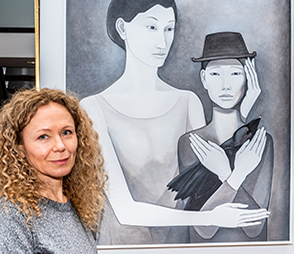 Olga Nenazhivina
Olga Nenazhivina
All of my drawing together are just one big painting the size of my whole life that I never stopped working on. You wake up and all your efforts are directed towards sitting at a table to continue your work. Before each new work I place a blank sheet in front of myself and attempt to understand it: feel its texture, character, and choose an approach that would fit. Working on a painting is like a relationship between people; a week may suffice for one but not even an eternity for another.
Viktoriya Rakhmanova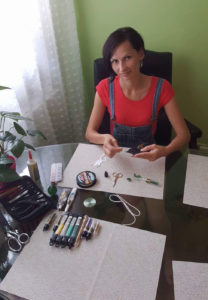
I really like working with natural stones, wild, unprocessed, without cutting. They are alive, breathing nature. I also like to use druses in my products – these minerals with overgrown crystals always look magical. I use Swarovski crystals, Czech beads and Japanese beads. I really like to work with the trunzal wire belongs to gold embroidery, its roots go back to Byzantine culture.
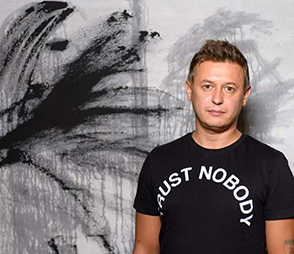 Ruslan Tremba:
Ruslan Tremba:
In my works I use mirrored colours and metallic foil. Due to the mirrored surface the viewer is able to see himself reflected in the work. That way he himself becomes part of the work, he is present in my landscapes thereby transforming and personalizing them. I call it My realism – the realism of presence. Using minimalistic one-color surface of the works I aim to convey peacefulness and quiet, which is sometimes difficult to notice. I try to drag the viewer into that moment where this quiet inhabits. That’s what I aimed to achieve in my works The Fog, By the Lake, The Silver Forest.
During this exhibition we present to the American public our debutant Tetiana Ridosh:
Artist Statement: I am a creative and dedicated artist with a passion for transforming emotions into captivating visual art. My work combines modern techniques with a deep appreciation for natural textures. I specialize in creating layered, dimensional pieces that evoke depth and invite exploration with expertise in modeling paste, acrylics, epoxy resin and textured mediums.
I believe my work to empower and inspire other people. Art is not only about creating—it’s about connecting with oneself and the world around you.


